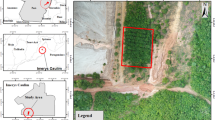Abstract
The effects of removing aboveground vegetation on survival and growth of Hondo spruce (Picea jezoensis var. hondoensis) saplings were examined in a dense dwarf bamboo (Sasa nipponica) field inside a deer-proof fence built in a degraded sub-alpine forest on Mt Ohdaigahara, central Japan. All bamboo culms were removed within a radius of 1 m from each sapling in a plot of 0.6 ha (removal plot), whereas no culms were removed in two control plots of 0.1 ha. We measured the height, crown depth, and main shoot elongation over 1 year for all spruce saplings, culm height and cover ratios of dwarf bamboo growing around each spruce sapling, and the light levels above each sapling. Removal of dwarf bamboo regulated the culm height and bamboo coverage until the following summer such that light conditions improved. The mortality of saplings smaller than the average culm height was lower in the removal plot (0.89%) than in a control plot (5.9%). After bamboo removal, sapling height growth was reduced with increasing bamboo cover in the previous year. Complete removal of the aboveground portions of covering bamboo improved sapling survival while regulating elongation growth, possibly because of the sudden increase in light intensity. Thus, controlling the extent of dwarf bamboo removal might be necessary to facilitate the growth of spruce saplings to restore the forest.
Similar content being viewed by others
References
Ando M, Itaya A, Yamamoto S, Shibata E (2006) Expansion of dwarf bamboo, Sasa nipponica, grassland under feeding pressure of sika deer, Cervus nippon, on subalpine coniferous forest in central Japan. J For Res 11:51–55
Bouffard D, Nolet P, Delagrange S, Lorenzetti F, Yamasaki S (2007) Vegetation control treatments to favor naturally regenerated Betula alleghaniensis saplings following seed-tree cut: sapling monitoring two years after treatment. Restor Ecol 15:679–687
Côté SD, Rooney TP, Tremblay J, Dussault C, Waller DM (2004) Ecological impacts of deer overabundance. Ann Rev Ecol Evol Syst 35:113–147
Crawley M (2002) Statistical computing: an introduction to data analysis using S-plus. Wiley, London
Gill R (1992) A review of damage by mammals in north temperate forests: 3. Impact on trees and forests. Forestry 65:363–388
Harmon M, Franklin J (1989) Tree seedlings on logs in Picea-Tsuga forests of Oregon and Washington. Ecology 70:48–59
Ide H, Kameyama A (1972) Vegetation of Ohdaigahara. Appl Bot Soc 1:1–48 (in Japanese)
Itô H, Hino T (2004) Effects of deer, mice and dwarf bamboo on the emergence, survival and growth of Abies homolepis (Piceaceae) seedlings. Ecol Res 19:217–223
Itô H, Hino T (2005) How do deer affect tree seedlings on a dwarf bamboo-dominated forest floor? Ecol Res 20:121–128
Itô H, Hino T (2007) Dwarf bamboo as an ecological filter for forest regeneration. Ecol Res 22:706–711
Kawahara T (1978) Studies on Sasa communities (IV) relation between cutting time and reproduction of Sasa nipponica. Jpn J For Soc 60:467–469 (in Japanese)
Kisanuki H, Nakasu M, Nakai A, Yurugi Y (2008) Predicting the population dynamics of three understory broad-leaved evergreen species under the influence of Sika deer in primary and secondary forests of mid-western Japan. J For Res 13:52–58
Kisanuki H, Nakai A, Nadamoto A, Wakino M (2009) Pits and rocky microsites in a subalpine forest stand facilitate regeneration of spruce saplings by suppressing dwarf bamboo growth inside a deer-proof fence. J For Res 14:342–348
Kneeshaw D, Williams H, Nikinmaa E, Messier C (2002) Patterns of above- and below-ground response of understory conifer release 6 years after partial cutting. Can J For Res 32:255–265
Kumar S, Takeda A, Shibata E (2006) Effects of 13-year fencing on browsing by sika deer on seedlings on Mt Ohdaigahara, central Japan. J For Res 11:337–342
Mori A, Takeda H (2004a) Effects of undisturbed canopy structure on population structure and species coexistence in an old-growth subalpine forest in central Japan. For Ecol Manag 200:89–100
Mori A, Takeda H (2004b) Functional relationships between crown morphology and within-crown characteristics of understory saplings of three codominant conifers in a subalpine forest in central Japan. Tree Physiol 24:661–670
Narukawa Y, Yamamoto S (2002) Effects of dwarf bamboo (Sasa sp.) and forest floor microsites on conifer seedling recruitment in a subalpine forest, Japan. For Ecol Manag 163:61–70
Prach K, Leps J, Michalek J (1996) Establishment of Picea abies seedlings in a central European mountain grassland: an experimental study. J Veg Sci 7:681–684
R Development Core Team (2007) R version 2.8. The R Foundation for Statistical Computing, Vienna
Sekine T, Sato H (1992) Tree barking by Sika deer, Cervus nippon Temminck, on Mt Odaigahara. Jpn J Ecol 42:241–248 (in Japanese with English summary)
Shimoda K, Kimura K, Kanzaki M, Yoda K (1994) The regeneration of pioneer tree species under browsing pressure of Sika deer in an evergreen oak forest. Ecol Res 9:85–92
Yokoyama S, Koizumi T, Shibata E (1996) Food habits of sika deer as assessed by fecal analysis in Mt Ohdaigahara, central Japan. J For Res 1:161–164
Yokoyama S, Maeji I, Ueda T, Ando M, Shibata E (2001) Impact of bark stripping by sika deer, Cervus nippon, on subalpine coniferous forests in central Japan. For Ecol Manag 140:93–99
Author information
Authors and Affiliations
Corresponding author
About this article
Cite this article
Kisanuki, H., Kudo, T. & Nakai, A. Removing aboveground vegetation facilitates survival but slows height growth of spruce saplings in a fenced, degraded sub-alpine forest in central Japan. J For Res 17, 110–115 (2012). https://doi.org/10.1007/s10310-011-0252-y
Received:
Accepted:
Published:
Issue Date:
DOI: https://doi.org/10.1007/s10310-011-0252-y




